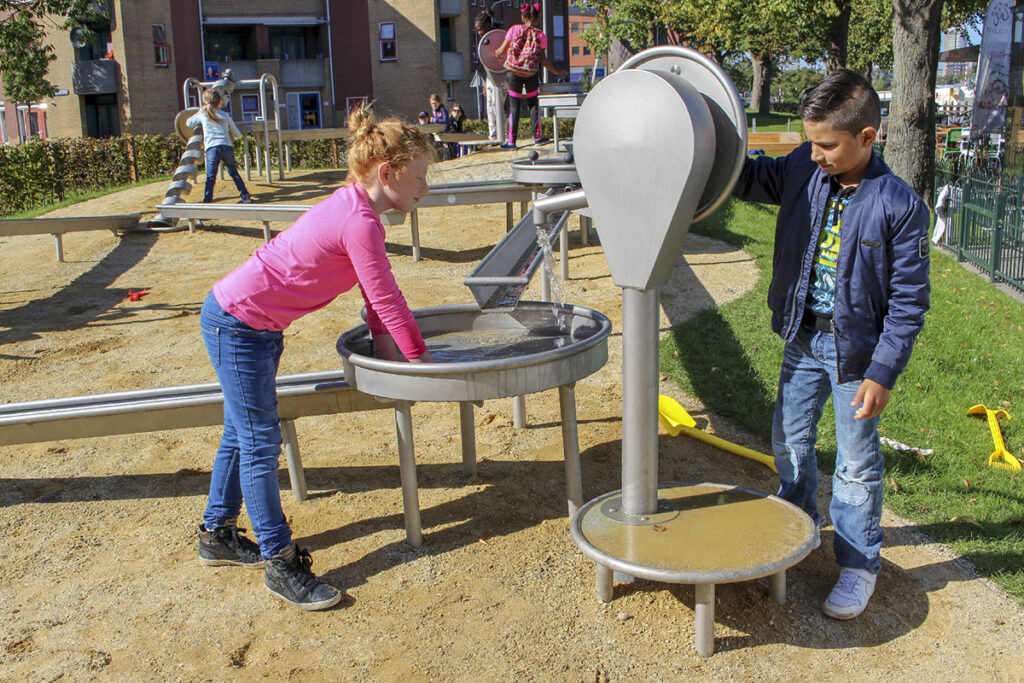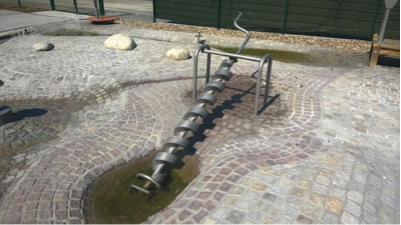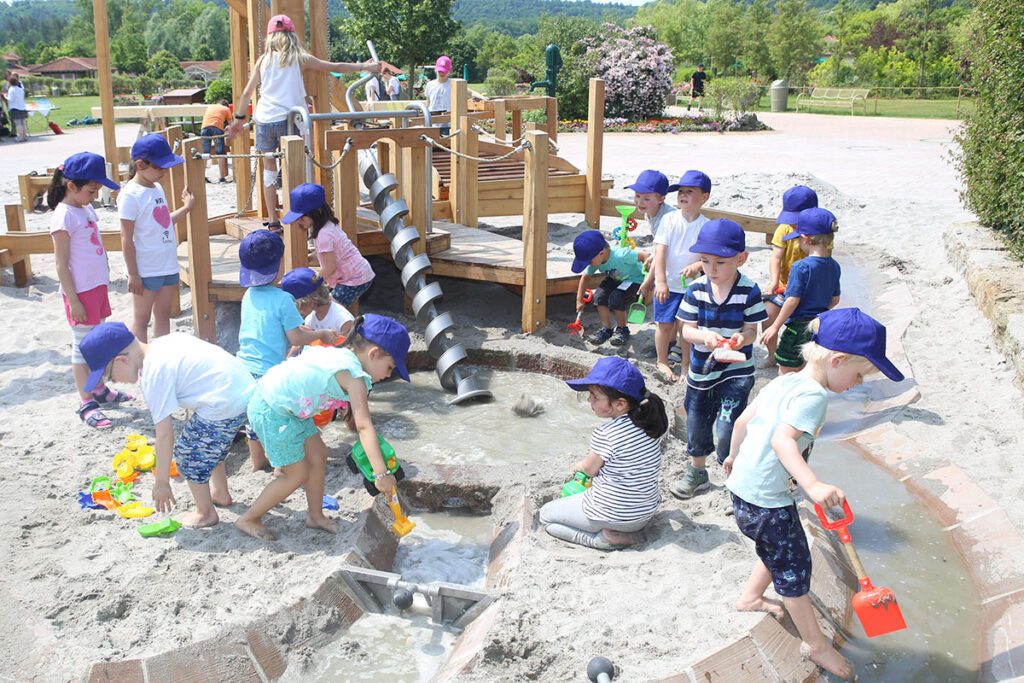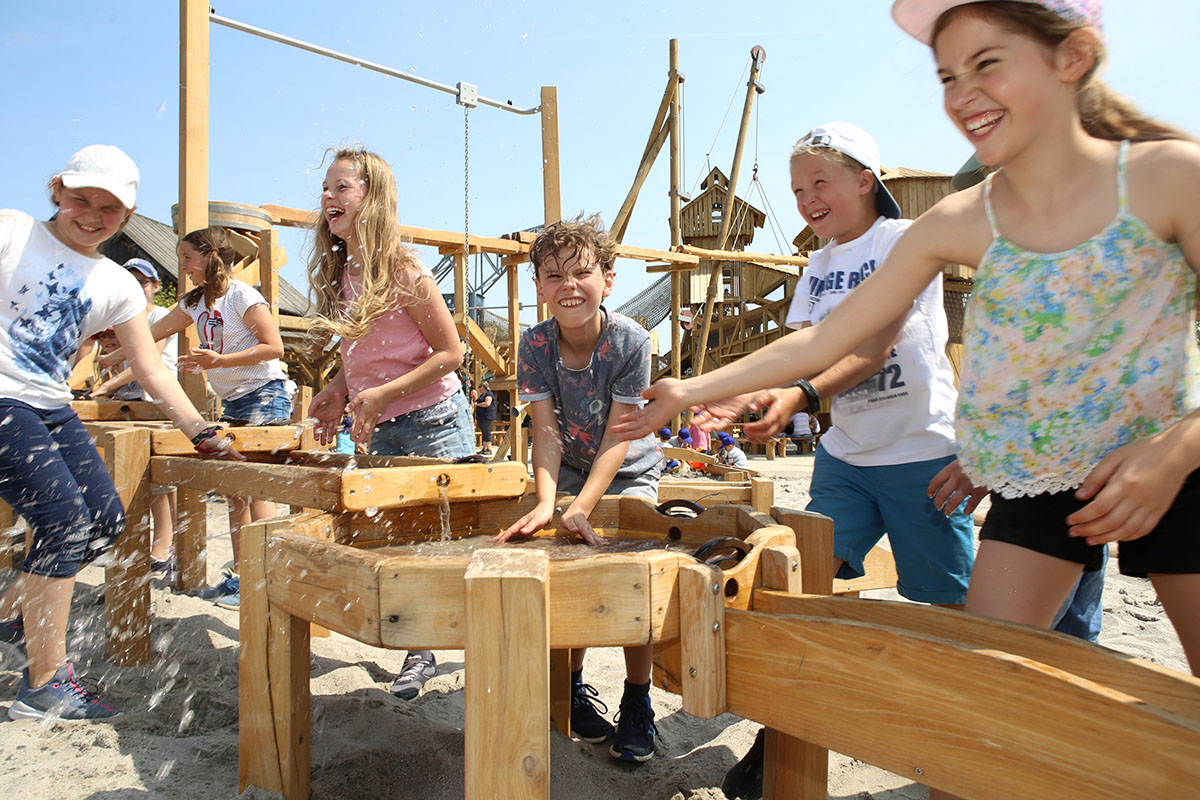Water play is a real highlight for children. Playing with water is not only fun but also educationally valuable. Water is physics you can touch. No wonder that puddles, lakes or the surf on the beach are magically attractive to young and old. Maybe it’s the diversity of water? Whether hot or cold, liquid or frozen, sparkling or still – the element glistening in the sunlight is simply a fascinating natural phenomenon. Water play, therefore, offers children maximum play fun but is, of course, also more elaborate in planning and maintenance than a normal playground. You can find out what to look out for in the following.
Table of content
- What is a water play?
- For what age is water play suitable?
- What is the educational value of water play?
- What standards and specifications must a water play meet?
- The maintenance of water play
- Water play: It’s worth the effort
What is a water play?
Water play features in playgrounds that are mainly designed for playing with water. Regular playgrounds can also have individual water play elements. The three essential components of water playgrounds are:
- Water play equipment such as pumps, spring outlets or fountains.
- Watercourses, play channels or play areas (e.g. mud boxes)
- Water drains
Pumping systems, mud boxes, and watercourses are ideal for inspiring children’s imagination. Channels made of wood or metal can be transport routes for little boats or encourage experiments with dams. Elements that are integrated into the environment and combined with the banks of streams, for example, are also beautiful.


What ages is water play suitable for?
The beauty of a water play is that it works across all ages. Older children operate pumps while the little ones watch, help build dams or play in the muddy area. All the children communicate and interact with each other. Teamwork comes into being all by itself: it takes children to bring water into the system, to procure building materials and close leaks, or to receive little ships sailing on the channel. In water play, children seem to find it particularly easy to enter into a joint game.
What is the educational value of water play?
Every water playground offers children an excellent opportunity to experience nature. Because there, they can playfully explore, test and create. Which objects sink and which float? How much water does a dam hold? Which ingredients make the best mud? Water play promotes the following skills:
- Gross and fine motor skills, risk assessment and self-awareness
- Technical and scientific understanding
- Creativity
- Social skills such as communication, empathy and responsibility.
Water appeals to all the senses. A good water play facility should, therefore, also have areas that actively promote the above-mentioned skills. The challenge in planning is to build a water playground that is as open as possible in its use so that it allows random as well as free play.

What standards and specifications must water play meet?
Anyone planning water play must consider not only the design but also the technical requirements and the safety of the users, just as with any other playground planning. DIN 18034 (Playgrounds and open spaces for play – requirements for planning, construction and operation) and DIN EN 1176-1 (Playground equipment and playground flooring – general safety requirements) serve as a basis. For nurseries, further information can be found in DGUV Information 202-019 Natural play areas.
More on the topic of standards and specifications with regard to water quality can be found in our article “DIN 18034 – Hygiene regulations for water in the playground”.
Protecting children from drowning
When it comes to water depth, the following should be considered depending on the age of the child: DIN 18034:2012 already requires a maximum water depth of 40 cm. According to DGUV information, a water depth of 20 cm should not be exceeded in nurseries with standing water. Planners must, therefore, carefully consider which maximum depth applies. The current revision of DIN 18034 will probably provide some guidance. The recent drafts propose, for example, to allow a water depth of 60 cm for special raft-like playground equipment.
The following considerations are helpful in deciding on an appropriate water depth:
- What age group will predominantly use the water playground?
- Do the children play supervised or unsupervised?
- Are there clearly separated play areas for different age groups?
It must be clearly recognisable whether play areas are suitable for younger or older children. This way, they will not be surprised by the deep water. In general, care should be taken that slopes are not too steep and that the riparian area offers sufficient space. The water level of streams near the playground should not exceed 40 cm, and there should be no major currents.
Good water quality is mandatory
For play purposes, water does not necessarily have to be of drinking water quality. Nevertheless, it should meet the requirements for its physical, chemical and, above all, microbiological quality. The Drinking Water Ordinance only applies to pumps and fountains that could be mistaken for drinking water dispensers because of their appearance. If the water from said dispensers is not drinking water, playground operators must clearly indicate this. In general, the EC Bathing Water Directive is a good basis in terms of water quality. In general, playground water should at least correspond to the quality of bathing water. This applies above all to water pools. Groundwater and rainwater are usually of good quality and may be used for the water playground. The water in playgrounds must be checked regularly by qualified personnel.
The right fall protection for water play
Water play elements often offer opportunities for climbing. Therefore, planners should also pay attention to the correct fall height here. According to EN 1176-1, playground equipment may not exceed a maximum fall height of 60 cm on concrete or stone, for example. An alternative is gravel, which can be displaced by currents, but also gives feet a good foothold on the bank due to its deformability. Please note that porous materials may not be easy to clean and may become algae.
Maintenance of water play
Safety is an important aspect of water playgrounds. Conscientious inspection and maintenance of play equipment are required to prevent accidents and injuries. As with all playgrounds, DIN EN 1176-7 Maintenance and Operation applies. How difficult it is to clean usually depends on the location of the playground in question. Natural materials such as twigs, blossoms and leaves can make cleaning more difficult but are harmless. The same applies to mud and slush, which can stick to playground equipment. A simple splash of water can help against this. Much of the water play equipment, such as pumps and flow pipes, rinses and cleans itself through frequent use. In addition, as already mentioned, the water quality should be checked regularly and professionally in order to maintain the required quality of the playground water.

Water play: The effort is worth it
Even if a water playground is more complex to plan and maintain than a regular playground – it is definitely worth the effort. The play and educational value of a water playground is particularly high because water fascinates, and playing with the elements brings children together across age groups. Find out how important water play is for child development in our blog post on water play & children!
To read on: Your little ones want to splash around with water, but there’s no water playground nearby? Here we have collected great water games that you can play in the garden, but also in the house!
Sources:
Playground & Landscape (05/2018)
Pichl, Walter: Playing with Water. In: G. Agde, H. Degünther, A. Hünnekes (eds.): Spielplätze und Freiräume zum Spielen. A Handbook for Planning and Operation. Beuth, 2013.:

